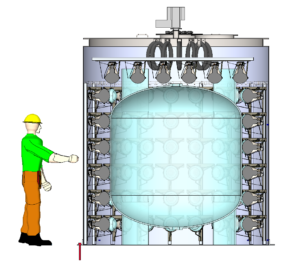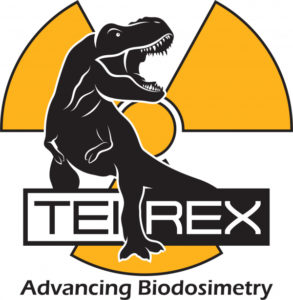Many at the Lab are aware of the opportunities offered by the national security-related agencies, which include the Department of Defense (DoD), Department of Homeland Security (DHS), DOE’s NNSA, and the intelligence community. Funding offered by these agencies often complements funding from other, traditional sources, advancing core research programs at the Lab.
John Valentine, head of the Lab’s Office of National & Homeland Security (ONHS), notes, “While LBNL’s bread and butter is Office of Science sponsors, complementary funding from security agencies can often enhance those research programs, enabling additional scientific staff to be included or pursuing aspects that are not addressed by the Office of Science program.” Two Lab research programs are recent examples.
National Nuclear Security Administration Funds Neutrino Detector Prototype Project
Physicist and nuclear scientist Gabriel Orebi Gann, who joined Berkeley Lab in 2012 to work on neutrino physics, this year received an award of $10 million over three years from the National Nuclear Security Administration (NNSA) to build a prototype neutrino detector.
“Neutrinos are important for understanding basic laws of the universe, including heat production beneath the surface of the Earth, how the universe was formed, and a broad range of additional fundamental research. Because nuclear fission produces antineutrinos, they are also useful for monitoring nuclear reactors, an application in which NNSA is interested,” explained Gabriel.
To better understand how neutrinos behave, her team had already developed a benchtop-scale detector, with funding support from both the Office of Science and NNSA. The benchtop detector can be used to inform predictions for larger-scale experiments, but as a next step, a prototype was needed that can demonstrate detection capabilities. There wasn’t near-term funding available from the Office of Science to build that demonstration prototype, so when the NNSA opportunity arose, Gabriel’s team jumped at it.
“The NNSA award is a huge catalyst for advancing the technology for neutrino detection. In addition to the development of a detector that can support nuclear reactor monitoring efforts, it will advance our efforts to detect and understand neutrinos, so it supports fundamental science as well as application development,” said Gabriel.

IARPA Contract Funds Radiation Exposure Detection Research
The Biosciences Area has a long history of defining the mechanisms and consequences of low-dose radiation responses in tissues and complex biological systems.
This field of research has been supported by the Department of Energy, however, after 2015 much of this work pivoted to studies of the adverse health effects of space radiation, funded by NASA. Additionally, in 2018, with Laboratory Directed Research and Development (LDRD) support, Biological Systems and Engineering (BSE) Division scientists, working with the Berkeley Lab Laser Accelerator (BELLA) Center in the Accelerator Technology and Applied Physics (ATAP) Division, initiated studies on the unique biological effects of ultrafast pulses of laser driven protons.
There are other federal agencies that are interested in the radiation impacts and other topics of biological interest. Intelligence Advanced Research Projects Activity, also known as IARPA, an organization within the Office of the Director of National Intelligence, funded a biosecurity research project called Finding Engineering-Linked Indicators (FELIX). The Lab performed Test and Evaluation for this program. With this established relationship, IARPA reached out to Susan Celniker, Senior Scientist and Deputy of Science in BSE, looking for research expertise in low-dose radiation, and she encouraged them to visit Berkeley Lab to learn about the Lab’s capabilities and facilities, including BELLA, the Advanced Light Source (ALS), and the 88-inch Cyclotron.
 In 2021, IARPA awarded the Lab a contract to be the Test and Evaluation team for three and a half years for a project named Targeted Evaluation of Ionizing Radiation Exposure (TEI-REX). Today, scientists in the Biosciences, Physical Sciences, and Computing Sciences Areas and Lab user facilities are working on this project.
In 2021, IARPA awarded the Lab a contract to be the Test and Evaluation team for three and a half years for a project named Targeted Evaluation of Ionizing Radiation Exposure (TEI-REX). Today, scientists in the Biosciences, Physical Sciences, and Computing Sciences Areas and Lab user facilities are working on this project.
“The IARPA contract has had a tremendous impact on our ability to continue to study the effects of low-dose radiation on biological systems. This is an important area of research that remains under-explored,” said Antoine Snijders, Staff Scientist in BSE and PI of the TEI-REX LBNL contract.
“We are excited to work with IARPA and the performing teams to establish novel biodosimetry approaches enabling improved quantification of low-dose ionizing radiation exposures,” said Jian-Hua Mao, Senior Scientist in BSE working on the TEI-REX program.
The team also includes Ben Brown, Staff Scientist in the Environmental Genomics and Systems Biology Division, who leads the computational component of the project. “The IARPA work helped revive a partially dormant, but potent skill set at the Lab. We are now in an excellent position with the knowledge and expertise that we have built these last few years, to present a real competitive advantage in this space for future projects,” added Ben, who is working with the Computational Biosciences Group in the Computing Science Area’s Scientific Data Division to apply critical machine learning expertise to the effort.
The timing could be right. Depending on the outcome of a pending Congressional legislation and appropriations bill, the Department of Energy may revive its low-dose radiation program.
John Valentine noted that security agencies have long been providing funding to complement and strengthen research at the Lab. Examples include the projects by Cameron Geddes’ team in BELLA to detect and identify nuclear materials with a precise photon beam, produced using a portable technology which leverages research on compact plasma-based accelerators, and by Mike Sohn’s team in the Energy Technologies Area’s Energy Analysis & Environmental Impacts Division extending indoor air transport modeling capabilities to chemical and biological agents. He said, “There are lots of opportunities for PIs across the lab through national security agencies. The ONHS office can help teams explore those opportunities and provide support for pursuing them.”
For more information about opportunities with national security agencies, contact John Valentine at jdvalentine@lbl.gov.

